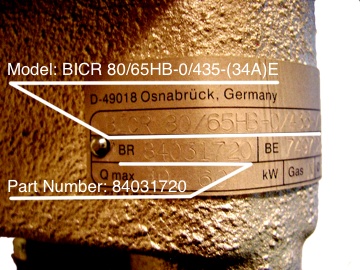Q: I need some new spark ignitors for my burners. Is that something that I can buy from Combustion 911?
A: Combustion 911 carries stock of the components required to create ignition electrodes (also called “spark ignitors”) and ionization electrodes (also called “sense electrodes” or “flame-rods”) for a wide range of Elster Kromschröder pilot and industrial burners. We assemble these electrodes to the manufacturer’s specifications, and depending on the quantity required and material availability, we can usually turn them around within a short time.
In pilot and industrial burners, ignition electrodes are used to provide a spark for ignition, and ionization electrodes are used to sense the presence of flame. These electrodes are commonly composed of an alloy rod of a manufacturer-specified length, and a selection of ceramic insulators spaced along the rod at manufacturer-specified intervals. Kromschröder’s electrodes often incorporate a star-shaped tip, though some electrodes may have a straight end, or a ninety-degree bend at the tip. Ninety-degree tips should be directed into the flame path when installed.
Additional components may be required for a more complete industrial burner electrode assembly. The free end of the electrode rod in many Kromschröder burners is affixed to a spark plug by means of a small spring clip, and both of these pieces are available as spare parts. A spark plug boot (also called an “electrode boot,” “electrode adapter,” “spark plug adapter,” or “electrode connector”) is either a straight or ninety-degree piece that allows the spark plug to interface with the ignition cable, and is typically made of plastic, though some incorporate rubber pieces (for high-moisture areas) and a ceramic model is available (for high-temperature installations). Spare spark plug boots and ignition cable can also be purchased from Combustion 911.
Ignition cable is used to connect the ignition electrode to the ignition transformer, and to connect the ionization electrode to the flame relay. In some cases (most often with small pilot burners), the same electrode can be used to provide both the ignition and the ionization functions. This is often called “spark and sense” or “single electrode” operation. In this scenario, it is important to use flame relays and ignition transformers that have spark and sense functionality.
Electrodes are always specific to the burner, so while pictures of the electrode can be helpful (especially if made against a tape-measure), the most important information to give a Combustion 911 representative is the burner’s 8-digit part number. The model (or “type code”) can also help us identify the correct electrode(s), but if the burner nameplate is accessible, all of the relevant information should be available there. Below is an example of a typical Kromschröder burner nameplate, from a BICR 80/65HB-0/435-(34A)E.
Of course, situations arise where customers do not have access to the burner nameplate, or where their records do not contain the required information. There are also cases where Combustion 911 does not have the specification information on file for certain electrodes, or where electrodes have been modified after manufacture, and the details of the modification may not be recorded. In these instances, if we think we can recreate the electrode(s), we may ask customers to ship a sample to our facility. As long as we have the necessary components, we should be able to use the sample to make the required replacement(s). If we cannot create the electrode(s) you need, we’ll quote current lead times from the manufacturer.
Since electrodes are burner-specific, it stands to reason that they may differ widely between burner manufacturers. We can manufacture many different burner electrodes, and we have industry partnerships that enable us to supply nearly any burner electrode in use today. The same rules apply, though. In addition to the manufacturer of the burner, we will also need to know that burner’s model and part number.
There are dozens of manufacturers providing the industry with components for combustion systems, and everybody does things differently. Please don’t hesitate to email questions that arise as a result of, or due to confusion regarding a pending, Kromschröder purchase to support_ab@combustion911.com.












